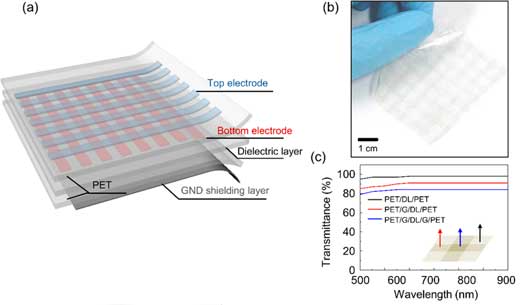| Posted: Jul 26, 2017 | |
Graphene touch sensor for wearable electronics(Nanowerk News) Researchers in Korea have developed a wearable and stretchable mutual capacitance touch sensor based on graphene electrodes that is capable of multitouch sensing as well as 3D sensing in a highly deformed state. |
|
| They report their findings in ACS Nano ("Graphene-Based Three-Dimensional Capacitive Touch Sensor for Wearable Electronics"). | |
 |
|
| Transparent and flexible graphene-based touch sensor. (a) Schematic diagram illustrating the concept of a graphene-based capacitive sensor. The sensor consists of three layers. The top and bottom layers are composed of patterned graphene electrodes on a PET film substrate. (b) Representative image of an electronic skin with a capacitive, multifunctional sensor array. (c) Optical transmittances for the top and bottom panels of the graphene-based capacitive sensor. (© ACS) | |
| While a considerable amount of research has been conducted on the development of graphene-based touch sensors for a variety of practical applications over the past decade, many limitations remain. | |
| Only touch sensors designed for rigid electronics and resistive-type touch sensors for detecting a single touch have been demonstrated because of the difficulty involved in fabricating capacitive, 3D, multitouch sensors based on transparent graphene electrodes in a wearable or stretchable format. | |
| The wearable and stretchable capacitive touch sensor presented by the Korean team addresses these difficulties by enabling multifinger touch sensing as well as 3D sensing while mounted on highly deformable human body parts. | |
 |
|
| Electrical properties and performances of touch sensor. Image of wearable capacitive touch sensor fabricated using graphene electrodes. The images below show the touch sensor monitor and the multitouch, spread, and scroll performances. Scale bar, 2 cm. (© ACS) | |
| The use of graphene as a transparent electrode enables the fabrication of a thin and stretchable device, which improves the resulting functionality and capabilities by minimizing mechanical failure during operation. | |
| The resulting graphene-based 3D touch sensor can be directly mounted onto deformable human body parts, including the forearms and palms, and it exhibits significant stretchability (∼15%) and good sensing capability in contact as well as noncontact modes (22 dB SNR at 7 cm distance). | |
| "Although much effort will be required to render the approach presented here compatible with currently existing technology and applicable to practical devices, this is a potential route toward a key application of graphene in emerging wearable electronics," the authors conclude their report. |
 By
Michael
Berger
– Michael is author of three books by the Royal Society of Chemistry:
Nano-Society: Pushing the Boundaries of Technology,
Nanotechnology: The Future is Tiny, and
Nanoengineering: The Skills and Tools Making Technology Invisible
Copyright ©
Nanowerk LLC
By
Michael
Berger
– Michael is author of three books by the Royal Society of Chemistry:
Nano-Society: Pushing the Boundaries of Technology,
Nanotechnology: The Future is Tiny, and
Nanoengineering: The Skills and Tools Making Technology Invisible
Copyright ©
Nanowerk LLC
|
|
|
Subscribe to a free copy of one of our daily Nanowerk Newsletter Email Digests with a compilation of all of the day's news. |
